杨忠《语言学概论》笔记
语言学概论笔记
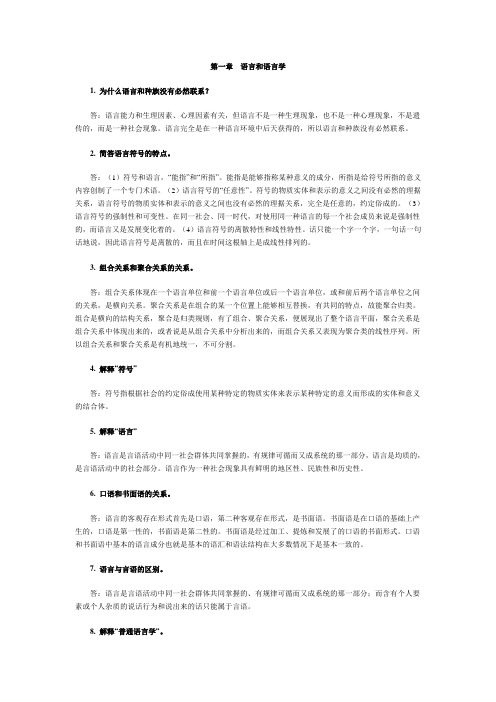
第一章语言和语言学1. 为什么语言和种族没有必然联系?答:语言能力和生理因素、心理因素有关,但语言不是一种生理现象,也不是一种心理现象,不是遗传的,而是一种社会现象。
语言完全是在一种语言环境中后天获得的,所以语言和种族没有必然联系。
2. 简答语言符号的特点。
答:(1)符号和语言,“能指”和“所指”。
能指是能够指称某种意义的成分,所指是给符号所指的意义内容创制了一个专门术语。
(2)语言符号的“任意性”。
符号的物质实体和表示的意义之间没有必然的理据关系,语言符号的物质实体和表示的意义之间也没有必然的理据关系,完全是任意的,约定俗成的。
(3)语言符号的强制性和可变性。
在同一社会、同一时代,对使用同一种语言的每一个社会成员来说是强制性的,而语言又是发展变化着的。
(4)语言符号的离散特性和线性特性。
话只能一个字一个字,一句话一句话地说,因此语言符号是离散的,而且在时间这根轴上是成线性排列的。
3. 组合关系和聚合关系的关系。
答:组合关系体现在一个语言单位和前一个语言单位或后一个语言单位,或和前后两个语言单位之间的关系,是横向关系。
聚合关系是在组合的某一个位置上能够相互替换,有共同的特点,故能聚合归类。
组合是横向的结构关系,聚合是归类规则,有了组合、聚合关系,便展现出了整个语言平面,聚合关系是组合关系中体现出来的,或者说是从组合关系中分析出来的,而组合关系又表现为聚合类的线性序列。
所以组合关系和聚合关系是有机地统一,不可分割。
4. 解释“符号”答:符号指根据社会的约定俗成使用某种特定的物质实体来表示某种特定的意义而形成的实体和意义的结合体。
5. 解释“语言”答:语言是言语活动中同一社会群体共同掌握的,有规律可循而又成系统的那一部分,语言是均质的,是言语活动中的社会部分。
语言作为一种社会现象具有鲜明的地区性、民族性和历史性。
6. 口语和书面语的关系。
答:语言的客观存在形式首先是口语,第二种客观存在形式,是书面语。
杨忠---语言学概论中文版学习指导东北师范大学
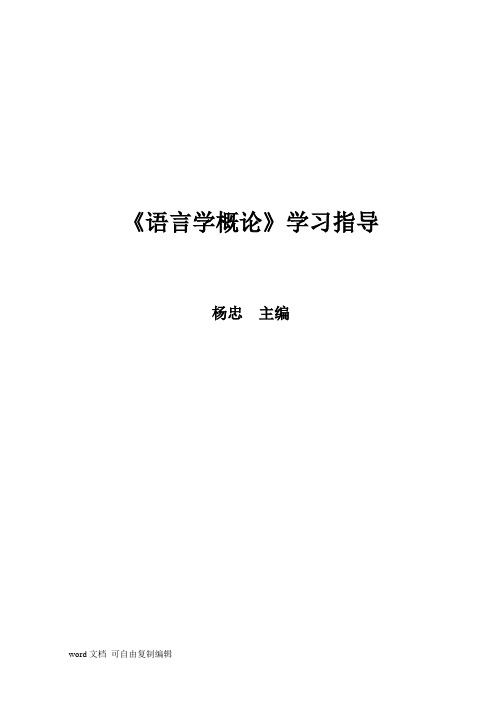
《语言学概论》学习指导杨忠主编《语言学概论》学习指导主编杨忠副主编:林正军魏昆编者(按姓氏笔画排序)王泽霞王晶芝杨忠林正军《语言学概论学习指导》是为网络课程学历教育考生编写的学习指导书,既可用于网络语言学课程的大纲及教材辅导,亦可用作语言学课程教学的辅导材料。
语言学作为与外语教学密切相关的学科之一,在外语教学中的地位和作用越来越显著。
在大学英语本科专业,语言学已被当作一门重要的专业课开设。
同时,语言学也是外语教师职业发展和培训的必修课。
为了配合《语言学概论》(杨忠主编,高等教育出版社,2002)这本教材的教与学,我们组织编写了这本学习指导用书。
本书与教材相对应,共分为十章,每章包括导读、重点与难点、习题及语言学名家介绍四部分。
本书的编写体例由杨忠、林正军和魏昆共同商定。
具体分工如下:杨忠负责序言部分的撰写、以及全书的审校工作;王泽霞负责第一至三章及综合测试题一至四的编写;王晶芝负责第四至六章及综合测试题五至八的编写;林正军负责第七至十章及综合测试题九至十的编写、以及全书的统稿工作;魏昆负责全书的校对和编排工作。
本书语言学名家简介部分的编写参考了刘润青的《西方语言学流派》(外语教学与研究出版社,2004)、当代国外语言学与应用语言学文库的相关导读部分、以及中国学术期刊全文数据库的部分文章,在此我们向以上著作及文章的作者致谢!本书在编写过程中得到东北师范大学出版社魏昆老师以及出版社的大力支持,在此表示衷心感谢!编者2006年2月19日序第一章语言和语言学导读本章重点、难点本章习题语言学名家介绍—费迪南·德·索绪尔第二章语音学导读本章重点、难点本章习题语言学名家介绍—维伦·马泰休斯第三章音位学导读本章重点、难点本章习题语言学名家介绍—路易斯·叶姆斯列夫第四章形态学:词的构成研究导读本章重点、难点本章习题语言学名家介绍—布龙菲尔德第五章句法:句子结构分析导读本章习题语言学名家介绍—乔姆斯基第六章语义学导读本章重点、难点本章习题语言学名家介绍—杰弗瑞·利奇第七章语用学导读本章重点、难点本章习题语言学名家介绍—约翰·塞尔第八章社会语言学导读本章重点、难点本章习题语言学名家介绍—威廉·拉波夫第九章第二语言习得导读本章重点、难点本章习题语言学名家介绍—约翰·鲁珀特·弗斯第十章语言学与外语教学导读本章习题语言学名家介绍—韩礼德绪论漫谈外语教师学习语言学杨忠就“从语言学中学什么”和“怎样学习语言学”两个相关的话题与年轻的外语同行们交流一下学习语言学的体会,代为序。
语言学概论笔记(第三章)(3)
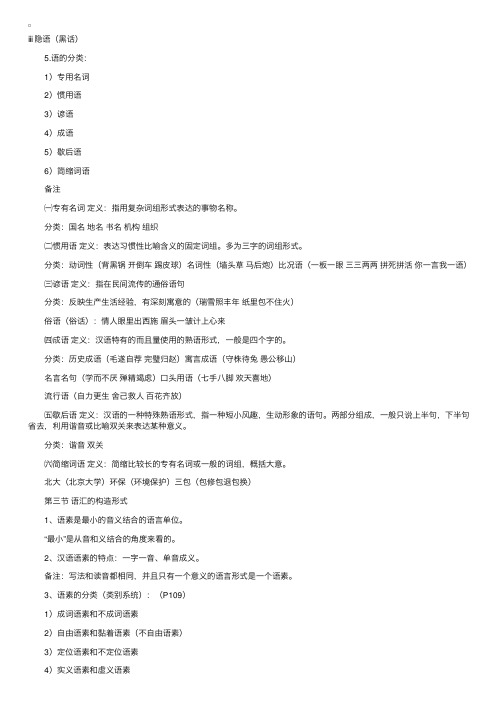
ⅲ隐语(⿊话) 5.语的分类: 1)专⽤名词 2)惯⽤语 3)谚语 4)成语 5)歇后语 6)简缩词语 备注 ㈠专有名词定义:指⽤复杂词组形式表达的事物名称。
分类:国名地名书名机构组织 ㈡惯⽤语定义:表达习惯性⽐喻含义的固定词组。
多为三字的词组形式。
分类:动词性(背⿊锅开倒车踢⽪球)名词性(墙头草马后炮)⽐况语(⼀板⼀眼三三两两拼死拼活你⼀⾔我⼀语) ㈢谚语定义:指在民间流传的通俗语句 分类:反映⽣产⽣活经验,有深刻寓意的(瑞雪照丰年纸⾥包不住⽕) 俗语(俗话):情⼈眼⾥出西施眉头⼀皱计上⼼来 ㈣成语定义:汉语特有的⽽且量使⽤的熟语形式,⼀般是四个字的。
分类:历史成语(⽑遂⾃荐完璧归赵)寓⾔成语(守株待兔愚公移⼭) 名⾔名句(学⽽不厌殚精竭虑)⼝头⽤语(七⼿⼋脚欢天喜地) 流⾏语(⾃⼒更⽣舍⼰救⼈百花齐放) ㈤歇后语定义:汉语的⼀种特殊熟语形式,指⼀种短⼩风趣,⽣动形象的语句。
两部分组成,⼀般只说上半句,下半句省去,利⽤谐⾳或⽐喻双关来表达某种意义。
分类:谐⾳双关 ㈥简缩词语定义:简缩⽐较长的专有名词或⼀般的词组,概括⼤意。
北⼤(北京⼤学)环保(环境保护)三包(包修包退包换) 第三节语汇的构造形式 1、语素是最⼩的⾳义结合的语⾔单位。
“最⼩”是从⾳和义结合的⾓度来看的。
2、汉语语素的特点:⼀字⼀⾳、单⾳成义。
备注:写法和读⾳都相同,并且只有⼀个意义的语⾔形式是⼀个语素。
3、语素的分类(类别系统):(P109) 1)成词语素和不成词语素 2)⾃由语素和黏着语素(不⾃由语素) 3)定位语素和不定位语素 4)实义语素和虚义语素 备注:(⼀)成词语素和不成词语素 ①成词语素指在某些情形下可以直接形成为词,即可以单⽤的语素。
(如:AB类) ②不成词语素指不能单独成词,即不能单⽤的语素。
(如CD类) (⼆)⾃由语素和黏着语素 ①⾃由语素指某种语素既可以单独形成词,有时⼜可以单独说出来。
(如A类) ②黏着语素(不⾃由语素)指永远不能单独说出来,根本不能形成词。
语言学概论整理笔记

导论一、语言学对象:人类的语言名词解释:以语言为研究对象的一门独立学科三大发祥地:中国、印度、希腊—罗马分科:⑴理论语言学1、个别语言语言学:以某一种具体语言为研究对象的语言学。
包括共时语言学和历时语言学。
(如汉语语言学和英语语言学)A、共时语言学:语言研究的一种方法,从一个横断面研究语言在某个历时时期的状态和展。
(描写语言学,例如对汉语普通话的研究,主要研究它发展到现在语音系统的状况,它有多少音位,音位之间的组合规则,而不管这些规则是由什么演变而来的)B、历时语言学:语言研究的一种方法,其中研究语言在较长历史时期中所经历的变化。
(历史语言学,例如上古汉语中有很多辅音结尾的音节,【-p】【-t】【-k】,而发展到现在就只留下【-n】【ng】结尾的音节了。
)2、普通语言学:以人类一般语言为研究对象,研究人类语言的性质、结构特征、发展规律,是综合众多语言的研究成果的研究成果而建立起来的语言学,是语言学的重要理论部分。
3、应用语言学:研究语言学应用的学科,实际上是一种交叉学科,是相关学科的学者将语言学的基本原理同有关学科结合起来研究问题而产生的新的学科。
4、小学:中国传统的语文学,围绕阐释和解读先秦典籍来展开研究,从而诞生了分析字形的文字学、研究字音的音韵学、解释字义的训诂学,从而被人们称为经血的附庸。
5、历史比较语言学:语言学中的一个重要部门,它以历史比较法为基础,研究语言的亲属关系。
它为现代语言学的建立奠定了坚实的基础,是语言学走上独立发展道路的标志。
(我们可以把汉语语音、词汇、语法从古至今的“纵”的历史放到今天由南至北的“横”的区域上去考察)第一章、语言的本质现代语言学之父:德·索绪尔语言:作为人类必不可少的思维工具和最重要的交际工具来使用的一种音义结合的符号统。
言语:是对语言的运用。
一是指人的说和写的过程,是人的一种行为,叫言语活动,也叫言语行为,一是指人说出来的话,写出来的东西,也叫言语作品。
语言学概论读书笔记
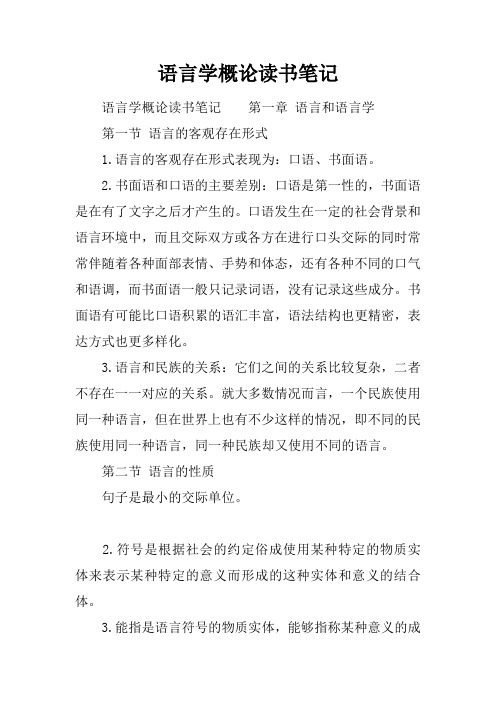
语言学概论读书笔记语言学概论读书笔记第一章语言和语言学第一节语言的客观存在形式1.语言的客观存在形式表现为:口语、书面语。
2.书面语和口语的主要差别:口语是第一性的,书面语是在有了文字之后才产生的。
口语发生在一定的社会背景和语言环境中,而且交际双方或各方在进行口头交际的同时常常伴随着各种面部表情、手势和体态,还有各种不同的口气和语调,而书面语一般只记录词语,没有记录这些成分。
书面语有可能比口语积累的语汇丰富,语法结构也更精密,表达方式也更多样化。
3.语言和民族的关系:它们之间的关系比较复杂,二者不存在一一对应的关系。
就大多数情况而言,一个民族使用同一种语言,但在世界上也有不少这样的情况,即不同的民族使用同一种语言,同一种民族却又使用不同的语言。
第二节语言的性质句子是最小的交际单位。
2.符号是根据社会的约定俗成使用某种特定的物质实体来表示某种特定的意义而形成的这种实体和意义的结合体。
3.能指是语言符号的物质实体,能够指称某种意义的成分。
4.所指是语言符号所指的意义内容。
5.组合关系是一个语言单位和前一个或后一个语言单位,或和前后两个语言单位之间的关系叫组合关系,也叫“句段关系”。
它体现在互相关联的语言单位组成的整体中。
6.聚合关系是在同一位置上可以互相替换出现的各个语言单位之间的关系。
7.语言与言语的区别:语言是使一个人能够理解和被他人理解的全部语言习惯,是社会成员约定俗成共同使用的部分,是均质的,是言语活动的社会部分;言语则具有个人特色,因为每个人说话的嗓音,每个音的具体发音,使用的词语和句子结构都不尽相同。
即语言是言语活动中同一社会群体共同掌握的,有规律可循而又成系统的那一部分;而含有个人要素或个人杂质的说话行为和说出来的话(包括写出来的“话”)只能属于言语。
8.语言符号的特征:任意性、强制性与可变性。
人们最初创制单个的语言符号时,用什么样的形式——语音与什么样的内容——语义相结合,并没有什么必然性,而带有很大的偶然性或随意性。
语言学概论笔记(第三章)(1)

第三章语汇 第⼀节语汇的性质 1.语汇是语⾔的建筑材料。
2.语汇是词和语的总和。
3.语汇是集合概念,是词和语的汇集,指⼀种语⾔中全部词和语的整体。
4.词是最⼩的⾳义结合的能独⽴使⽤的语⾔单位。
5.语汇的性质和特点: 1)语汇在产⽣时既有任意性,⼜有理据性。
①语⾔在初始阶段发⾳表义多是任意的,但也有部分词语(同源词,复合词)其⾳义联系有理据性。
②任意性和理据性是统⼀的;任意性是语汇得以产⽣的途径,理据性是语汇不断丰富的⼿段。
2)语汇在表达上既有普遍性,⼜有民族性。
①所有的词语本质上是对客观事物的反映,这是普遍性,但词语对客观事物的表达和概念上⼜反映出某个民族的独特认识,这是语汇的民族性。
②普遍性和民族性是统⼀的;普遍性使得各种语⾔得语汇能表达⼤量共同得概念,⽽民族性使得某种语⾔得语汇⼜能体现⼀些独特得认识。
3)语汇在变化中既有活跃性,⼜有稳定性。
①语汇随着社会⽣活得发展⽽变化更替:消失,增加,这是语汇得活跃性。
但语汇得变化⼜要受到社会约定和语汇系统得严格制约,⼜极强得稳定性。
②活跃性和稳定性是统⼀的:活跃性使得语汇的个体元素不断的增加和更替,是为了满⾜社会⽣活变化的需要,但稳定性使得语汇的基本成分和整体系统保持了固定和平衡,这也是为了保证社会交际能够正常进⾏。
6.语汇学指研究语汇背后的规律性和系统性以及语汇的结构关系和类别的学科,是语⾔结构的⼀个分⽀学科。
7.传统的语⾔学把语⾔结构系统分为:语⾳语汇和语法三要素 8.现代的语⾔学把语⾔结构系统分为:语⾳语法和语义三要素 第⼆节语汇的类聚系统 1.词和语的共同特点: ①都是最基本的语⾔单位; ②都具有意义凝固,形式固定的特点。
2.词的特点: ①既是语汇单位,⼜是语法单位。
②词的定义:最⼩的,⾳义结合的能独⽴使⽤的语⾔单位。
3.语的特点: ①只是语汇单位,不是语法单位。
②语的定义:由两个以上的词构成,但意义⽐较凝固,⼜经常作为⼀个整体单位使⽤的固定词组或熟语性语⾔⽚段。
语言学概论详细笔记

语言学概论详细笔记(总27页)--本页仅作为文档封面,使用时请直接删除即可----内页可以根据需求调整合适字体及大小--语言学概论目录目录 ................................................................................................................... 错误!未定义书签。
导言.................................................................................................................. 错误!未定义书签。
一、语言学的对象和任务 ....................................................................... 错误!未定义书签。
二、语言学的分类和分支学科................................................................ 错误!未定义书签。
三、语言学的功用 ................................................................................... 错误!未定义书签。
第一章语言的社会功能................................................................................... 错误!未定义书签。
第一节语言的社会功能 ........................................................................... 错误!未定义书签。
一、语言和说话的关系 .................................................................. 错误!未定义书签。
语言学概论详细笔记
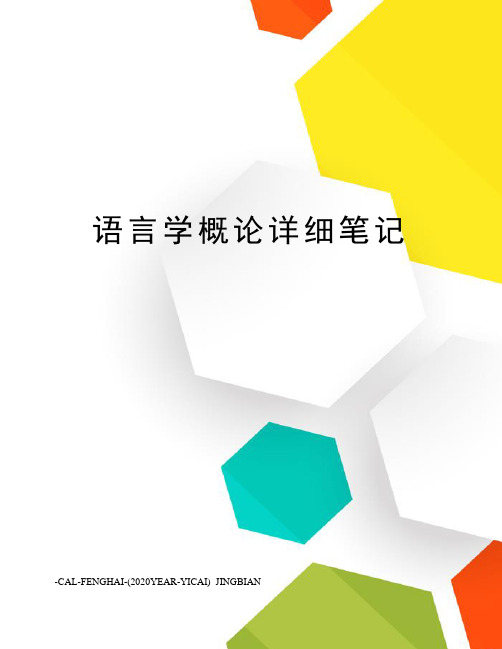
语言学概论详细笔记-CAL-FENGHAI-(2020YEAR-YICAI)_JINGBIAN语言学概论目录目录 ................................................................................................................... 错误!未定义书签。
导言.................................................................................................................. 错误!未定义书签。
一、语言学的对象和任务 ....................................................................... 错误!未定义书签。
二、语言学的分类和分支学科................................................................ 错误!未定义书签。
三、语言学的功用 ................................................................................... 错误!未定义书签。
第一章语言的社会功能................................................................................... 错误!未定义书签。
第一节语言的社会功能 ........................................................................... 错误!未定义书签。
一、语言和说话的关系 .................................................................. 错误!未定义书签。
语言学概论笔记(第六章)(2)

备注: ㈠表意⽂字;全部字符都是意符的⽂字。
㈡表⾳⽂字;全部字符都是⾳符的⽂字是表⾳⽂字,表⾳⽂字习惯上⼜称为拼⾳⽂字。
㈢意⾳⽂字;⼀部分字符是意符,⼀部分字符是⾳符的⽂字是意⾳⽂字。
5 .应该如何看待⼀些表⽰⽐较复杂意思的图画以及夹杂⼀部分字符的图画跟⽂字的关系:因为⽂字是语⾔的书写符号系统,所以关键是要看某种图形是不是跟确定的语⾔单位相结合。
如果某种图形跟语⾔单位没有确定的关系,只表⽰⼀个⼤致的意义,可以⽤不同的词语和语句去解释,那么图形就不是⽂字。
6.汉字是⼀种什么类型的⽂字:汉字根据字符跟语⾔中什么样的语⾔单位相联系的标准来分类,是⼀种词语⽂字;⽽根据字符跟语⾔单位的语义还是语⾳相联系的标准来分类,是⼀种意⾳⽂字。
第⼆节⽂字和语⾔ 1.语⾔的特点对⽂字的特点是有影响的,但不能把这种影响绝对化: ①⽂字是书写语⾔的符号系统,⽂字是再语⾔的基础上产⽣的,因此⽂字的特点和语⾔的特点是由⼀定的联系的。
(列举的事实见250页) ②但这种影响不能绝对化,绝对化的观点⽬前还缺少证据。
(列举的事实见251页) 2.⽂字也会影响语⾔,但⽆限夸⼤⽂字对语⾔的影响是没有根据的: ①⽂字对语⾔的影响主要是帮助语⾔克服了时间和空间的局限性,使语⾔的功能⼤⼤加强和扩展了。
②⽂字的类型会影响语⾔之间的相互影响,因为在现代社会⾥语⾔之间的影响主要是通过书⾯语进⾏的,⽂字类型相同会促进这种影响,⽽⽂字类型不同会在不同程度上阻碍这种影响。
③但⽂字对语⾔的影响是有限的。
现在说⽂字的种种神奇作⽤,归根到底都是语⾔本⾝,包括⼝语和书⾯语的作⽤。
3.为什么说⽂字和语⾔关系密切,但⼆者⼜不能画等号: ①⽂字是语⾔的书写符号系统,⽂字是在语⾔的基础上产⽣的,是记录语⾔的⼯具,⽽不是语⾔本⾝。
②⽂字⾄少包括三个不同的义项: (1)书写或记录语⾔的符号,也说“字”或“字母”。
(2)语⾔的书⾯形式或书⾯语,如中⽂、英⽂等。
语言学概论笔记(第四章)(1)

第⼀节语法的性质 1、组词造句必须符合⼀定的规则。
2、语法规则是直觉知识和约定习惯。
3、语法规则的性质和特点: ①语法规则具有⾼度的抽象性 ②语法规则具有强⼤的递归性 ③语法规则具有严密的系统性 ④语法规则具有相对的稳定性 备注(⼀)⾼度的抽象性 ①所谓“抽象”指的是对具体东西进⾏类的概括。
语法规则实际上就是对⼈们说的话中的单位、结构和关系的某种类的概括。
②语法规则具有抽象性,它才成为⼀种概括的规则,即语法不必去管⼀个⼀个具体的词语和句⼦,⽽只需处理⼀类⼀类的现象。
③有了抽象的语法规则,⼈们在说话时才可能由此及彼,以类相从,在由各种类别构建的单位、结构和关系的框架内造出⼀句⼀句“合格”的话来。
(⼆)强⼤的递归性 ①所谓“递归”指的是相同的规则可以在⼀个结构⾥重复使⽤。
语法规则实际上就是⼀种有限⼿段可以反复使⽤的规则。
②语法规则具有递归性,它才是⼀种简明的规则,只需重复使⽤有限的⼏条规则就能管住⼤量的现象。
③有了递归的语法规则,⼈们在说话时才可能举⼀反三,以简驭繁,⽤数量有限的规则⼿段造出⼀句⼀句⽆限多的话来。
(三)严密的系统性 ①所谓“系统”指的是语法规则具有推导性和解释性。
语⾔中的每⼀条语法规则并不是独⽴起作⽤的,⼀条规则之外往往还有另⼀条规则管着。
②语法规则具有系统性,它才是⼀种有解释⼒的规则,即语法规则实际上环环相扣,这⼀条规则往往受另⼀条规则制约,或者说另⼀条规则可以补充这⼀条规则。
③有了系统的语法规则,⼈们在说话时才能形散神聚,变⽽不乱,造出⼀句⼀句复杂多样但⼜严密有序的话来。
(四)相对的稳定性 ①所谓“稳定”指的是语法规则与语⾳、语汇这样⼀些与地域差异、社会发展关系⼗分紧密的语⾔要素⽐较起来,变化现象⽐较少,变化过程也⼗分缓慢。
②语法规则具有稳定性,它才成为⼀种有效的规则,即规则⼀旦形成就不⼤可能随意增加或废⽌。
③有了稳定的语法规则,在相当时期和范围内⼈们在说话时才可能⼼照不宣,运⽤⾃如,造出⼀句⼀句能够顺利进⾏交际和相互理解的话来。
语言学概论笔记(第三章)(5)
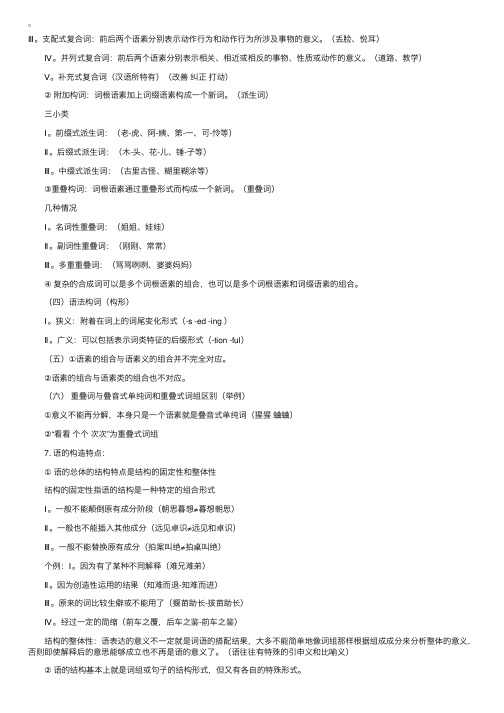
Ⅲ。
⽀配式复合词:前后两个语素分别表⽰动作⾏为和动作⾏为所涉及事物的意义。
(丢脸、悦⽿) Ⅳ。
并列式复合词:前后两个语素分别表⽰相关、相近或相反的事物、性质或动作的意义。
(道路、教学) Ⅴ。
补充式复合词(汉语所特有)(改善纠正打动) ②附加构词:词根语素加上词缀语素构成⼀个新词。
(派⽣词) 三⼩类 Ⅰ。
前缀式派⽣词:(⽼-虎、阿-姨、第-⼀、可-怜等) Ⅱ。
后缀式派⽣词:(⽊-头、花-⼉、锤-⼦等) Ⅲ。
中缀式派⽣词:(古⾥古怪、糊⾥糊涂等) ③重叠构词:词根语素通过重叠形式⽽构成⼀个新词。
(重叠词) ⼏种情况 Ⅰ。
名词性重叠词:(姐姐、娃娃) Ⅱ。
副词性重叠词:(刚刚、常常) Ⅲ。
多重重叠词:(骂骂咧咧、婆婆妈妈) ④复杂的合成词可以是多个词根语素的组合,也可以是多个词根语素和词缀语素的组合。
(四)语法构词(构形) Ⅰ。
狭义:附着在词上的词尾变化形式(-s -ed -ing ) Ⅱ。
⼴义:可以包括表⽰词类特征的后缀形式(-tion -ful) (五)①语素的组合与语素义的组合并不完全对应。
②语素的组合与语素类的组合也不对应。
(六)重叠词与叠⾳式单纯词和重叠式词组区别(举例) ①意义不能再分解,本⾝只是⼀个语素就是叠⾳式单纯词(猩猩蛐蛐) ②“看看个个次次”为重叠式词组 7. 语的构造特点: ①语的总体的结构特点是结构的固定性和整体性 结构的固定性指语的结构是⼀种特定的组合形式 Ⅰ。
⼀般不能颠倒原有成分阶段(朝思暮想≠暮想朝思) Ⅱ。
⼀般也不能插⼊其他成分(远见卓识≠远见和卓识) Ⅲ。
⼀般不能替换原有成分(拍案叫绝≠拍桌叫绝) 个例:Ⅰ。
因为有了某种不同解释(难兄难弟) Ⅱ。
因为创造性运⽤的结果(知难⽽退-知难⽽进) Ⅲ。
原来的词⽐较⽣僻或不能⽤了(揠苗助长-拔苗助长) Ⅳ。
经过⼀定的简缩(前车之覆,后车之鉴-前车之鉴) 结构的整体性:语表达的意义不⼀定就是词语的搭配结果,⼤多不能简单地像词组那样根据组成成分来分析整体的意义,否则即使解释后的意思能够成⽴也不再是语的意义了。
语言学概论笔记(第一章)

语言学概论笔记第一章:语言和语言学一、识记内容。
1、口语:语言的客观存在形式首先是有声的口头语言。
2、书面语:文字出现以后,语言的第二种客观存在形式。
3、符号:指的是根据社会的约定俗成使用某种特定的物质实体来表示某种特定的意义而形成的这种实体和意义的结合体。
4、能指:语言符号的物质实体能够指称某种意义的成分。
5、所指:也就是“能指成分”,即特定的物质实体,所指的意义内容。
6、聚合关系:在同一个位置上可以互相替换出现的各个语言单位处在互相可以联想起来的关系之中,因而聚合成为一个类。
7、组合关系:组合关系体现为一个语言单位和前一个语言单位或后一个语言单位,或和前后两个语言单位之间的关系,也体现了部分与整体之间的关系。
8、语言学:是研究语言的科学。
9、普通语言学:语言学界把研究人类社会的语言这种社会现象的一般理论。
10、理论语言学:把研究某种具体语言的语言学称为汉语语言学或英语语言学等等,把侧重理论探讨的称为理论语言学。
11、应用语言学:把侧重语言学理论和成果的实际应用。
12、传统语言学:一般泛指20世纪以前的语言学,特别是指索绪尔开创的结构主义语言学以前的语言学。
13、结构主义语言学:索绪尔创立的语言学可以称为“结构主义语言学”,至于我国内常说的“结构主义语言学”、“结构主义语法”,往往只是指在国外影响较大并且我国语言学界比较熟悉的美国结构主义描写语言学,那只是当代结构主义语言学的一个流派,并不等于受索绪尔影响的整个结构主义语言学。
二、领会内容(不用识记,大体知道即可)1、言语交际是一个编码和解码的过程。
答:人要说话所需要的因素:生活经历、社会环境、当前处理的问题、社会问题、文化问题、哲学问题、逻辑问题。
人要接受语言所需要的因素:组织与分析的能力、心理、生理问题;发音、听音的器官和神经网络及机制和能力;复杂的生理和物理问题。
总之一句话,言语交际是通过许多因素对语言进行编码和解码的过程,言者编码,听者解码。
语言学概论笔记(第四章)(2)
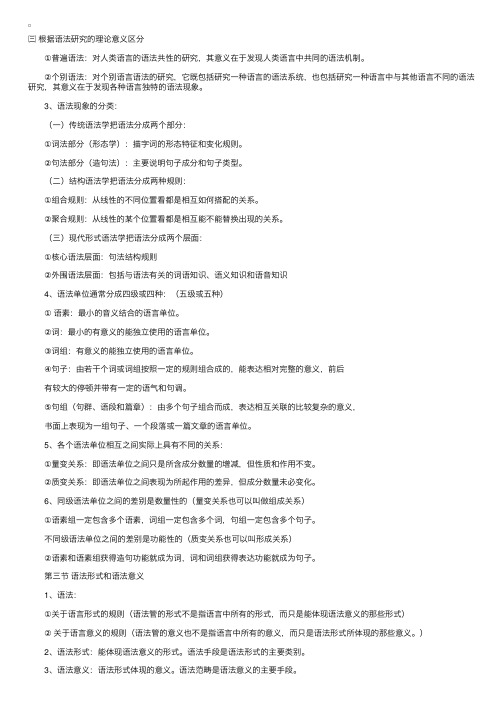
㈢根据语法研究的理论意义区分 ①普遍语法:对⼈类语⾔的语法共性的研究,其意义在于发现⼈类语⾔中共同的语法机制。
②个别语法:对个别语⾔语法的研究,它既包括研究⼀种语⾔的语法系统,也包括研究⼀种语⾔中与其他语⾔不同的语法研究,其意义在于发现各种语⾔独特的语法现象。
3、语法现象的分类: (⼀)传统语法学把语法分成两个部分: ①词法部分(形态学):描字词的形态特征和变化规则。
②句法部分(造句法):主要说明句⼦成分和句⼦类型。
(⼆)结构语法学把语法分成两种规则: ①组合规则:从线性的不同位置看都是相互如何搭配的关系。
②聚合规则:从线性的某个位置看都是相互能不能替换出现的关系。
(三)现代形式语法学把语法分成两个层⾯: ①核⼼语法层⾯:句法结构规则 ②外围语法层⾯:包括与语法有关的词语知识、语义知识和语⾳知识 4、语法单位通常分成四级或四种:(五级或五种) ①语素:最⼩的⾳义结合的语⾔单位。
②词:最⼩的有意义的能独⽴使⽤的语⾔单位。
③词组:有意义的能独⽴使⽤的语⾔单位。
④句⼦:由若⼲个词或词组按照⼀定的规则组合成的,能表达相对完整的意义,前后 有较⼤的停顿并带有⼀定的语⽓和句调。
⑤句组(句群、语段和篇章):由多个句⼦组合⽽成,表达相互关联的⽐较复杂的意义, 书⾯上表现为⼀组句⼦、⼀个段落或⼀篇⽂章的语⾔单位。
5、各个语法单位相互之间实际上具有不同的关系: ①量变关系:即语法单位之间只是所含成分数量的增减,但性质和作⽤不变。
②质变关系:即语法单位之间表现为所起作⽤的差异,但成分数量未必变化。
6、同级语法单位之间的差别是数量性的(量变关系也可以叫做组成关系) ①语素组⼀定包含多个语素,词组⼀定包含多个词,句组⼀定包含多个句⼦。
不同级语法单位之间的差别是功能性的(质变关系也可以叫形成关系) ②语素和语素组获得造句功能就成为词,词和词组获得表达功能就成为句⼦。
第三节语法形式和语法意义 1、语法: ①关于语⾔形式的规则(语法管的形式不是指语⾔中所有的形式,⽽只是能体现语法意义的那些形式) ②关于语⾔意义的规则(语法管的意义也不是指语⾔中所有的意义,⽽只是语法形式所体现的那些意义。
《语言学概论》笔记及复习重点
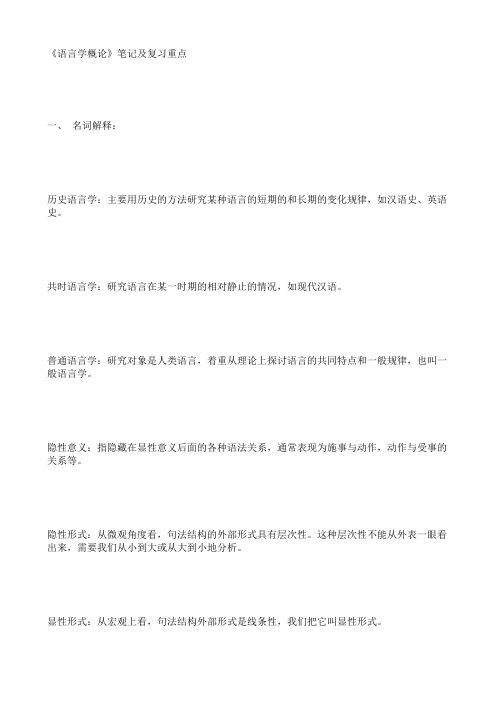
《语言学概论》笔记及复习重点一、名词解释:历史语言学:主要用历史的方法研究某种语言的短期的和长期的变化规律,如汉语史、英语史。
共时语言学:研究语言在某一时期的相对静止的情况,如现代汉语。
普通语言学:研究对象是人类语言,着重从理论上探讨语言的共同特点和一般规律,也叫一般语言学。
隐性意义:指隐藏在显性意义后面的各种语法关系,通常表现为施事与动作,动作与受事的关系等。
隐性形式:从微观角度看,句法结构的外部形式具有层次性。
这种层次性不能从外表一眼看出来,需要我们从小到大或从大到小地分析。
显性形式:从宏观上看,句法结构外部形式是线条性,我们把它叫显性形式。
语言学:是研究语言的科学。
语言学家研究的只是经过语言学家主观概括和不同程度上理想化和简单化了的语言。
符号:指的是根据社会的约定俗成使用某种特定的物质实体来表示某种特定的意义而形成的这种实体和意义的结合体。
“符号”必然包括有任何情况下永远不可分割的两个方面,一个方面是物质的实体,另一个方面是约定俗成的意义。
“能指”:是索绪尔给语言符号的物质实体创制的一个专门的术语。
也就是能够指称某种意义的成分。
“所指”:是索绪尔给符号所指的意义内容创制的一个专门术语,也就是“能指成分”,即特定的物质实体,所指的意义内容。
语音:虽是一种声音,但又与一般的声音有着本质的区别。
它是由人的发音器官发出的,负载着一定的意义,并作为语言符号系统载体的声音。
音素:是从音质角度划分出来的最小语音单位。
根据音质的不同,对一串语音不断加以切分,直到不能切分为止,这样得到的语音就是“音素”。
标写语音的书面符号叫做“音标”。
“音位”:就是从社会功能的角度划分出来的语音单位,它是特定语言或方言中具有区别意义作用的最小的语音单位。
“音质音位”和“非音质音位”:音位从构成材料上看,可以分为音质音位和非音质音位。
以音素为材料,通过音质的差别来起辨义作用的音位叫“音质音位”。
语音中除音质外,音高、音强、音长也能起这种作用,因此也构成音位。
语言学概论笔记+精华版

语言学概论笔记语言是以语音为物质外壳、以词汇为建筑材料、以语法为结构规律而构成的体系。
动物“语言”与人类语言的区别动物的这些传递信息的手段都不是语言。
能传递信息的手段并不就是语言。
动物传递信息的手段与人类语言有本质的不同。
二者的区别在于:动物是为了消极地适应环境,为了生存,信息简单,信息与生存本能联系在一起;人类是为了改造环境,信息复杂。
动物传递信息的手段极其简单,都是一些本能的动作、叫声、分泌物等;人类传递信息的手段——语言,十分复杂。
语言的复杂性表现在它的结构性、层级性上。
动物传递信息的手段不具备生成性;人类语言具有无限的生成性,即人可根据语言中的词及结构规则造出无限多的句子,表达无限的信息内容,也就是说,语言负载的信息内容是无限的。
动物没有伴随意识的语言(动物是无意识的),人类的语言和人类的意识紧密相联,是体现表达人类意识的物质手段(人类是有意识的)。
语言是以意识为其存在的前提,意识也以语言为存在前提。
也就是说,人类有了意识才有语言,也只有有了语言才有意识。
意识和语言是交织在一起的。
正如马克思所指出的:“语言和意识具有同样长久的历史,语言是一种实践的……现实的意识。
”人类语言的特点主要可从功能、构造、习得三个方面来看:功能开放:动物“语言”是一个封闭的系统,故只能传递极其有限的信息。
人类语言是一个开放系统,具有无限的生成性,可以根据不同时代、不同状况创造出从未有人说过的话,传递无限丰富的信息,大至宇宙苍穹,小至分子粒子,既可以反映先古的状况,今人的现实,也可叙述天堂地狱、仙境鬼域。
真是万事万物,无所不可谈的。
构造灵巧:人类语言能传递无限的信息,是依赖于语言自身的合理、灵巧的构造。
人类语言的构造包括两层:一是语音层,一是符号层。
语音层包括人类选用的几十个音,音通过排列组合构成一批音节,即一批“包装”意义的“容器”(教材语)。
意义是人认识事物的成果,这成果装进“容器”,固定成一个个离散的单位。
杨忠语言学笔记
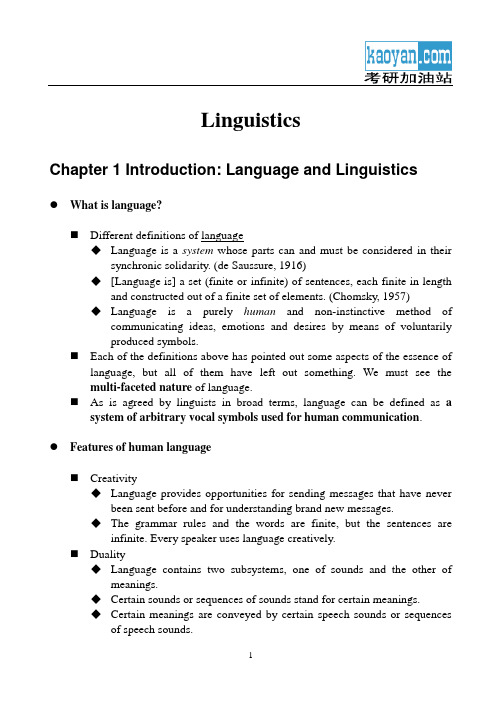
LinguisticsChapter 1 Introduction: Language and Linguistics●What is language?⏹Different definitions of language◆Language is a system whose parts can and must be considered in theirsynchronic solidarity. (de Saussure, 1916)◆[Language is] a set (finite or infinite) of sentences, each finite in lengthand constructed out of a finite set of elements. (Chomsky, 1957)◆Language is a purely human and non-instinctive method ofcommunicating ideas, emotions and desires by means of voluntarilyproduced symbols.⏹Each of the definitions above has pointed out some aspects of the essence oflanguage, but all of them have left out something. We must see themulti-faceted nature of language.⏹As is agreed by linguists in broad terms, language can be defined as asystem of arbitrary vocal symbols used for human communication.●Features of human language⏹Creativity◆Language provides opportunities for sending messages that have neverbeen sent before and for understanding brand new messages.◆The grammar rules and the words are finite, but the sentences areinfinite. Every speaker uses language creatively.⏹Duality◆Language contains two subsystems, one of sounds and the other ofmeanings.◆Certain sounds or sequences of sounds stand for certain meanings.◆Certain meanings are conveyed by certain speech sounds or sequencesof speech sounds.⏹Arbitrariness◆The relationship between the two subsystems of language is arbitrary.◆There is no logical connection between sound and meaning.⏹Displacement◆There is no limit in time or space for language.◆Language can be used to refer to things real or imagined, past, present orfuture.⏹Cultural transmission◆Culture cannot be genetically transmitted. Instead, it must be learned.◆Language is a way of transmitting culture.⏹Interchangeability◆All members of a speech community can send and receive messages.⏹Reflexivity◆Human languages can be used to describe themselves.◆The language used to talk about language is called meta-language.●Functions of language – three meta-functions⏹The ideational function◆To identify things, to think, or to record information.⏹The interpersonal function◆To get along in a community.⏹The textual function◆To form a text.●Types of language⏹Genetic classification⏹Typological classification◆Analytic language –no inflections or formal changes, grammaticalrelationships are shown through word order, such as Chinese andVietnamese◆Synthetic language –grammatical relationships are expressed bychanging the internal structure of the words, typically by changing theinflectional endings, such as English and German◆Agglutinating language – words are built out of a long sequence of units,with each unit expressing a particular grammatical meaning, such asJapanese and Turkish●The myth of language – language origin⏹The Biblical account◆Language was God’s gift to human beings.⏹The bow-wow theory◆Language was an imitation of natural sounds, such as the cries ofanimals, like quack, cuckoo.⏹The pooh-pooh theory◆Language arose from instinctive emotional cries, expressive of pain orjoy.⏹The yo-he-ho theory◆Language arose from the noises made by a group of people engaged injoint labour or effort – lifting a huge hunted game, moving a rock, etc.⏹The evolution theory◆Language originated in the process of labour and answered the call ofsocial need.●What is linguistics?⏹Linguistics is the scientific study of language.◆Observing & questioning◆Formulating hypotheses◆Verifying the hypotheses◆Proposing a theory⏹Branches of linguistics◆Internal branches: intra-disciplinary divisions●Phonetics●Phonology●Morphology●Syntax●Semantics◆External branches: inter-disciplinary divisions●Pragmatics●Psycholinguistics●Sociolinguistics●Applied linguistics●Computational linguistics●Neurolinguistics⏹Features of linguistics◆Descriptive◆Dealing with spoken language◆SynchronicChapter 2 Phonetics●What is phonetics?⏹Phonetics is termed as the study of speech sounds.⏹Sub-branches of phonetics◆Articulatory phonetics – the production of speech sounds◆Acoustic phonetics – the physical properties of speech sounds◆Auditory phonetics – the perceptive mechanism of speech sounds●The speech organs⏹Where does the air stream come from?◆From the lung⏹What is the function of vocal cords?◆Controlling the air stream⏹What are the cavities?◆Oral cavity◆Pharyngeal cavity◆Nasal cavity●Transcription of speech sounds⏹Units of representation◆Segments (the individual sounds)⏹Phonetic symbols◆The widely used symbols for phonetic transcription of speech sounds isthe International Phonetic Alphabet (IPA).◆The IPA attempts to represent each sound of human speech with a singlesymbol and the symbols are enclosed in brackets [ ] to distinguishphonetic transcriptions from the spelling system of a language.◆In more detailed transcription (narrow transcription) a sound may betranscribed with a symbol to which a smaller is added in order to markthe finer distinctions.●Description of speech sounds⏹Description of English consonants◆General feature: obstruction◆Criteria of consonant description●Places of articulation●Manners of articulation●V oicing of articulation◆Places of articulation●This refers to each point at which the air stream can be modified toproduce a sound.⏹Bilabial: [p] [b] [m] [w]⏹Labiodental: [f] [v]⏹Interdental: [ ] [❆]⏹Alveolar: [t] [d] [s] [z] [l] [n] [r]⏹Palatal: [☞] [✞] [t☞] [d✞] [j]⏹Velar: [k] [g] [☠]⏹Glottal: [h]◆Manners of articulation●This refers to how the air stream is modified, whether it iscompletely blocked or partially obstructed.⏹Stops: [p] [b] [t] [d] [k] [g]⏹Fricatives: [s] [z] [☞] [✞] [f] [v] [ ] [❆] [h]⏹Affricates: [t☞] [d✞]⏹Liquids: [l] [r]⏹Glides: [w] [j]⏹Nasals: [m] [n] [☠]◆V oicing of articulation●This refers to the vibrating of the vocal cords when sounds areproduced.⏹V oiced sounds⏹V oiceless sounds⏹Description of English vowels◆General feature: without obstruction◆Criteria of vowel description●Part of the tongue that is raised⏹Front⏹Central⏹Back●Extent to which the tongue rises in the direction of the palate⏹High⏹Mid⏹Low●Kind of opening made at the lips●Position of the soft palate◆Single vowels (monophthongs) and diphthongs●Phonetic features and natural classes⏹Classes of sounds that share a feature or features are called natural classes.⏹Major class features can specify segments across the consonant-vowelboundary.⏹Classification of segments by features is the basis on which variations ofsounds can be analyzed.Chapter 3 Phonology●What is phonology?⏹Phonology is the study of sound systems and patterns.⏹Phonology and phonetics are two studies different in perspectives, which areconcerned with the study of speech sounds.⏹Phonology focuses on three fundamental questions.◆What sounds make up the list of sounds that can distinguish meaning ina particular language?◆What sounds vary in what ways in what context?◆What sounds can appear together in a sequence in a particular language?●Phonemes and allophones⏹ A phoneme is a distinctive, abstract sound unit with a distinctive feature.⏹The variants of a phoneme are termed allophones.⏹We use allophones to realize phonemes.●Discovering phonemes⏹Contrastive distribution – phonemes◆If sounds appear in the same environment, they are said to be incontrastive distribution.◆Typical contrastive distribution of sounds is found in minimal pairs andminimal sets.● A minimal pair consists of two words that differ by only one soundin the same position.●Minimal sets are more than two words that are distinguished by onesegment in the same position.◆The overwhelming majority of the consonants and vowels representedby the English phonetic alphabet are in contrastive distribution.◆Some sounds can hardly be found in contrastive distribution in English.However, these sounds are distinctive in terms of phonetic features.Therefore, they are separate phonemes.⏹Complementary distribution – allophones◆Sounds that are not found in the same position are said to be incomplementary distribution.◆If segments are in complementary distribution and share a number offeatures, they are allophones of the same phoneme.⏹Free variation◆If segments appear in the same position but the mutual substitution doesnot result in change of meaning, they are said to be in free variation.●Distinctive and non-distinctive features⏹Features that distinguish meaning are called distinctive features, and featuresdo not, non-distinctive features.⏹Distinctive features in one language may be non-distinctive in another.●Phonological rules⏹Phonemes are abstract sound units stored in the mind, while allophones arethe actual pronunciations in speech.⏹What phoneme is realized by what allophones in what specific context isanother major question in phonology.⏹The regularities that what sounds vary in what ways in what context aregeneralized and stated in phonology as rules.⏹There are many phonological rules in English. Take the following ones asexamples.●[+voiced +consonant] – [-voiced]/[-voiced +consonant]_●[-voiced +bilabial +stop] – unaspirated/[-voiced +alveolar +fricative]_●Syllable structure⏹ A syllable is a phonological unit that is composed of one or more phonemes.⏹Every syllable has a nucleus, which is usually a vowel.⏹The nucleus may be preceded by one or more consonants called the onsetand followed by one or more consonants called the coda.●Sequence of phonemes⏹Native speakers of any language intuitively know what sounds can be puttogether.⏹Some sequences are not possible in English. The impossible sequences arecalled systematic gaps.⏹Sequences that are possible but do not occur yet are called accidental gaps.⏹When new words are coined, they may fill some accidental gaps but theywill never fill systematic gaps.●Suprasegmental features⏹Features that are found over a segment or a sequence of two or moresegments are called suprasegmental features.⏹These features are distinctive features.⏹Stress◆Stress is the perceived prominence of one or more syllabic elements overothers in a word.◆Stress is a relative notion. Only words that are composed of two or moresyllables have stress.◆If a word has three or more syllables, there is a primary stress and asecondary stress.◆In some languages word stress is fixed, i.e. on a certain syllable. InEnglish, word stress is unpredictable.⏹Intonation◆When we speak, we change the pitch of our voice to express ideas.◆Intonation is the variation of pitch to distinguish utterance meaning.◆The same sentence uttered with different intonation may expressdifferent attitude of the speaker.◆In English, there are three basic intonation patterns: fall, rise, fall-rise.⏹Tone◆Tone is the variation of pitch to distinguish words.◆The same sequence of segments can be different words if uttered withdifferent tones.◆Chinese is a typical tone language.Chapter 4 Morphology●What is morphology?⏹The total number of words stored in the brain is called the lexicon.⏹Words are the smallest free units of language that unite sounds withmeaning.⏹Morphology is defined as t he study of the internal structure and theformation of words.●Morphemes and allomorphs⏹The smallest meaningful unit of language is called a morpheme.⏹ A morpheme may be represented by different forms, called allomorphs.⏹“zero” form of a morpheme and suppletives◆Some countable nouns do not change form to express plurality. Similarly,some regular verbs do not change form to indicate past tense. In thesetwo cases, the noun or verb contains two morphemes, among whichther e is one “zero form” of a morpheme.◆Some verbs have irregular changes when they are in past tense. In thiscase, the verbs also have two morphemes. Words which are not relatedin form to indicate grammatical contrast with their roots are calledsuppletives.●Free and bound morphemes⏹Some morphemes constitute words by themselves. These morphemes arecalled free morphemes.⏹Other morphemes are never used independently in speech and writing. Theyare always attached to free morphemes to form new words. Thesemorphemes are called bound morphemes.⏹The distinction between a free morphemes and a bound morpheme iswhether it can be used independently in speech or writing.⏹Free morphemes are the roots of words, while bound morphemes are theaffixes (prefixes and suffixes).●Inflexional and derivational morphemes⏹Inflexional morphemes in modern English indicate case and number ofnouns, tense and aspect of verbs, and degree of adjectives and adverbs.⏹Derivational morphemes are bound morphemes added to existing forms toconstruct new words.◆English affixes are divided into prefixes and suffixes.◆Some languages have infixes, bound morphemes which are inserted intoother morphemes.◆The process of putting affixes to existing forms to create new words iscalled derivation. Words thus formed are called derivatives.●Conclusion: classification of morphemes⏹Morphemes◆Free morphemes◆Bound morphemes●Inflexional●Derivational: affixes⏹Prefixes: -s, -’s, -er, -est, -ing, -ed, -s⏹Suffixes●Formation of new words⏹Derivation◆Derivation forms a word by adding an affix to a free morpheme.◆Since derivation can apply more than once, it is possible to create aderived word with a number of affixes. For example, if we add affixes tothe word friend, we can form befriend, friendly, unfriendly, friendliness,unfriendliness, etc. This process of adding more than one affix to a freemorpheme is termed complex derivation.◆Derivation does not apply freely to any word of a given category.Generally speaking, affixes cannot be added to morphemes of a differentlanguage origin.◆Derivation is also constrained by phonological factors.◆Some English suffixes also change the word stress.⏹Compounding◆Compounding is another common way to form words. It is thecombination of free morphemes.◆The majority of English compounds are the combination of words fromthe three classes – nouns, verbs and adjectives – and fall into the threeclasses.◆In compounds, the rightmost morpheme determines the part of speech ofthe word.◆The meaning of compounds is not always the sum of meaning of thecomponents.⏹Conversion◆Conversion is the process putting an existing word of one class intoanother class.◆Conversion is usually found in words containing one morpheme.⏹Clipping◆Clipping is a process that shortens a polysyllabic word by deleting oneor more syllables.◆Clipped words are initially used in spoken English on informaloccasions.◆Some clipped words have become widely accepted, and are used even informal styles. For example, the words bus (omnibus), vet (veterinarian),gym (gymnasium), fridge (refrigerator)and fax (facsimile)are rarelyused in their complete form.⏹Blending◆Blending is a process that creates new words by putting togethernon-morphemic parts of existing words. For example, smog(smoke +frog), brunch (a meal in the middle of morning, replacing both breakfastand lunch), motel (motor + hotel). There is also an interesting word inthe textbook for junior middle school students –“plike” (a kind ofmachine that is like both a plane and a bike).⏹Back-formation◆Back-formation is the process that creates a new word by dropping a realor supposed suffix. For example, the word televise is back-formed fromtelevision. Originally, the word television is formed by putting the prefixtele- (far) to the root vision (viewing). At the same time, there is a suffix–sion in English indicating nouns. Then people consider the –sion in theword television as that suffix and drop it to form the verb televise.⏹Acronyms and abbreviations◆Acronyms and abbreviations are formed by putting together the initialletters of all words in a phrase or title.◆Acronyms can be read as a word and are usually longer thanabbreviations, which are read letter by letter.◆This type of word formation is common in names of organizations andscientific terminology.⏹Eponyms◆Eponyms are words that originate from proper names of individuals orplaces. For example, the word sandwich is a common noun originatingfrom the fourth Earl of Sandwich, who put his food between two slicesof bread so that he could eat while gambling.⏹Coinage◆Coinage is a process of inventing words not based on existingmorphemes.◆This way of word formation is especially common in cases whereindustry requires a word for a new product. For example, Kodak andCoca-cola.Chapter 5 Syntax●What is syntax?⏹The term syntax is from the ancient Greek word syntaxis, which literallymeans “arrangement” or “setting out together”.⏹Traditionally, it refers to the branch of grammar dealing with the ways inwhich words, with or without appropriate inflexions, are arranged to showconnexions of meaning within the sentence.⏹Syntax is a branch of linguistics that analyzes the structure of sentences.●What is a sentence?⏹Syntax is the analysis of sentence structure. A sentence is a sequence ofwords arranged in a certain order in accordance with grammatical rules.⏹ A sequence can be either well-formed or ill-formed. Native speakers of alanguage know intuitively what strings of words are grammatical and whatare ungrammatical.●Knowledge of sentence structure⏹Structural ambiguity◆Structural ambiguity is one or more string(s) of words has/have morethan one meaning. For example, the sentence Tom said he would comeyesterday can be interpreted in different ways.⏹Word order◆Different arrangements of the same words have different meanings. Forexample, with the words Tom, love and Mary, we may say Tom lovesMary or Mary loves Tom.⏹Grammatical relations◆Native speakers know what element relates to what other elementdirectly or indirectly. For example, in The boats are not big enough andWe don’t have enough boats, the word enough is related to differentwords in the two sentences.⏹Recursion◆The same rule can be used repeatedly to create infinite sentences. Forexample, I know that you are happy. He knows that I know that you arehappy. She knows that he knows that I know that you are happy.⏹Sentence relatedness◆Sentences may be structurally variant but semantically related.⏹Syntactic categories◆ A syntactic category is a class of words or phrases that can substitute forone another without loss of grammaticality. For example, consider thefollowing sentences:●The child found the knife.● A policeman found the knife.●The man who just left here found the knife.●He found the knife.◆All the italicized parts belong to the same syntactic category called nounphrase (NP). The noun phrases in these sentences function as subject.The knife, also a noun phrase, functions as object.●Traditional grammar⏹In traditional grammar, a sentence is considered a sequence of words whichare classified into parts of speech.⏹Sentences are analyzed in terms of grammatical functions of words: subjects,objects, verbs (predicates), predicatives, …⏹Compulsory elements of a sentence: subject, verb, object, complement,adverbial…⏹Nou ns: number, case, gender…⏹Verbs: tense, aspect, voice…⏹Adjectives and adverbs: comparative and superlative degrees⏹Agreement in number/person/gender⏹Parsing: trying to make detailed analysis in structure●Structural grammar⏹Structural grammar arose out of an attempt to deviate from traditionalgrammar. It deals with the inter-relationships of different grammatical units.In the concern of structural grammar, words are not just independentgrammatical units, but are inter-related to one another.⏹Form class◆Form class is a wider concept than part of speech in traditional grammar.◆Linguistic units which can appear in the same slot are said to be in thesame form class. For example, a(n), the, my, that, every,etc. can beplaced before nouns in English sentences. These words fall into oneform class.◆These linguistic units are observed to have the same distribution.⏹Immediate constituent (IC) analysis◆Structural grammar is characterized by a top-down process of analysis.◆ A sentence is seen as a constituent structure. All the components of thesentences are its constituents. A sentence can be cut into sections. Eachsection is its immediate constituent. Then each section can be further cutinto constituents. This on-going cutting is termed immediate constituentanalysis.◆Examples:●Old men and women: old | men and women, old || men | and women●The ||| little || girl | speaks || French.◆In this way, sentence structure is analyzed not only horizontally but alsovertically. In other words, IC analysis can account for the linearity andthe hierarchy of sentence structure.●I will suggest | that this || in itself reflects ||| a particular ideology|||| about gender ||||| that deserves to be re-examined.◆Two advantages of IC analysis:●It can analyze some ambiguities.●It shows linearity and hierarchy of one sentence.●Transformational-generative (TG) grammar⏹Background and the goal of TG grammar◆Chomsky (1957) – grammar is the knowledge of native speakers.●Adequacy of observation●Adequacy of description●Adequacy of explanation◆Writing a TG grammar means working out two sets of rules –phrasestructure rules and transformation rules –which are followed byspeakers of the language.◆TG grammar must account for all and only grammatical sentences.⏹Syntactic categories◆Noun Phrase (NP)◆Verb Phrase (VP)◆Sentence (S)◆Determiner (Det)◆Adjective (Adj)◆Pronoun (Pro)◆Verb (V)◆Auxiliary Verb (Aux)◆Prepositional Phrase (PP)◆Adverb (Adv)⏹Phrase structure (PS) rules◆S → NP VP(Det) (Adj) N◆NP →{Pro◆VP → (Aux) V (NP) (PP)◆PP → P NP⏹Tree diagrams (omit)⏹Recursion and the infinitude of language◆S contains NP and VP and that S may be a constituent of NP and VP. NPand PP can be mutually inclusive. If phrasal categories appear on bothsides of the arrow in phrase structure rules, the rules are recursive.Recursive rules can be applied again and again, and the phrase structurecan grow endlessly.⏹Sub-categorization of the lexicon.◆The process of putting words of the same lexical category into smallerclasses according to their syntactic characteristics is calledsub-categorization.⏹Transformational rules (T-rules)◆Particle movement T-rule●John turned the machine off. John turned off the machine.◆Replacement T-rule●John beat Tom. He beat Tom.●The house needs repairing (to be repaired).◆Insertion T-rule● A fish is swimming in the pond. There is a fish swimming in thepond.◆Deletion T-rule●They came in and (they) sat down.◆Copying T-rule●He is coming, isn’t he?●He has finished his homework, hasn’t he?◆Reflexivization T-rule●I wash me (myself).⏹TG grammar accounts for the mental process of our speaking.●Systematic-functional grammar⏹Background and the goal of systemic-functional grammar◆M. A. K. Halliday●Language is a system of meaning potential and a network ofmeaning as choices.●Meaning determines form, not vice versa. Meaning is realizedthrough forms.●The goal of systemic-functional grammar is to see how function andmeaning are realized through forms.●The three meta-functions of language⏹Ideational function⏹Interpersonal function⏹Textual function⏹The transitivity system of language◆Elements●Process●Participants●Circumstances◆Categorization of reality●Doing – material process⏹Processes involving physical actions: walking, running,throwing, kicking, wrapping, etc.⏹Actor, goal and circumstance●Being – relational process⏹Processes representing a relation being set up between twoseparate entities.⏹Be (identifying), have (attributive)⏹Carrier/possessor and attribute/possessed●Sensing – mental process⏹Processes of sensing, including feeling, thinking, perceiving,imagining, wanting, liking, etc.⏹Senser and phenomenon●Less central types of linguistic process⏹Verbal processes – saying something◆Sayer and receiver⏹Behavioural processes – active conscious processes◆Behaver and range⏹Existential processes – existence of an entity◆Existent⏹Mood and modality◆Mood expresses the speaker’s attitude and serves for interpersonalfunction. It is a syntactic constituent made up of the subject and thefinite.◆Modality is the degree of certainty or frequency expressed by thegrammatical forms of finite. It can be categorized by modalization andmodulation.⏹Theme and rheme◆Theme is the given information, while rheme is the new information.◆Examples:●John | is my friend.●He | should have replied to my letter.Chapter 6 Semantics●What is semantics?⏹Semantics is defined as the study of meaning. However, it is not the onlylinguistic discipline that studies meaning.⏹Semantics answers the question “what does this sentence mean”. In otherwords, it is the analysis of conventional meanings in words and sentences outof context.●Reference and sense⏹Linguistic expressions stand in a relation to the world. There are two aspectsof meaning.⏹Reference is the relation by which a word picks out or identifies an entity inthe world. But the referential theory fails to account for certain kinds oflinguistic expression.◆Some words are meaningful, but they identify no entities in the realworld, such as the words dragon, phoenix, unicorn, and mermaid.◆It is not possible for some words to find referent in the world, such asthe words but, and, of, however, the, etc.◆Speakers of English understand the meaning of a round trianglealthough there is no such graph.⏹Sense is the relation by which words stand in human mind. It is mentalre presentation, the association with something in the speaker’s or hearer’smind. The study of meaning from the perspective of sense is called therepresentational approach.●Classification of lexical meanings⏹Referential meaning (denotative meaning) – central meaning of words, stable,universal⏹Associative meaning –meaning that hinges on referential meaning, lessstable, more culture-specific◆Connotative meaning – the communicative value an expression has byvirtue of what it refers to, embraces the properties of the referent,。
语言学概论笔记(第五章)(3)

备注:(⼀)等义词: ①定义:包括理性意义和⾮理性意义(附加⾊彩)在内的词义完全相同的两个或两个以上的词。
②⼀般来说,等义词在语⾔中⼤多不能长期存在! ㈡近义词 ①定义:指理性意义相同或基本相同,但⼜有细微差别的两个或两个以上的词。
②⼀般所说的同义词绝⼤多数都属于近义词。
③近义词之间的差别:A表现在词的理性意义上B表现在⾮理性意义上。
C使⽤范围的不同。
④近义词的作⽤:A在说话或协作时选择恰当的近义词可正确表达⾃⼰的思想。
B很好的修辞⼿段,使语⾔表达精密,得体,富于变化,增强表达的效果。
㈢⼀个多义词可能在不同义项上与不同的词构成同义词。
14.反义词 1)定义:⼀种语⾔或⽅⾔中意义相反的两个词。
2)分类:① “绝对反义词”②“相对反义词”。
备注:(⼀)如果两个反义词处于⽭盾关系之中,肯定⼀⽅就必然否定另⼀⽅,否定⼀⽅就必然肯定另⼀⽅,两者之间没有⾮此⾮彼的中间状态存在,这类反义词就叫绝对反义词。
㈡如果两个反义词处在反对关系中,肯定⼀⽅就必然否定另⼀⽅,否定另⼀⽅则未必肯定另⼀⽅,⼆者之间存在着⾮此⾮彼的中间状态,这类反义词就叫相对反义词。
㈢在语⾔中,⼀个词可以和⼏个不同的词互为反义词。
㈣反义词的作⽤: ①利⽤反义词可以帮助我们在编纂词典时确定多义词的义项,可以帮助我们辨析近义词之间的细微差别。
②反义词在修辞上有对⽐作⽤,可以⽤来揭⽰⽭盾,突出对⽴⾯,增强语⾔的表现⼒。
15.词义有⼀定的系统性。
语义场就是这种词义系统性的重要表现。
16.语义场是指若⼲具有共同的类属义素的词语(义项)构成的聚合体,类属义素是指反映⼀物所属类别的语义特征。
17.语⾔中有些词所代表的事物范围⼤。
有些词所代表的事物范围⼩,如果后者所代表的事物可以完全包容在前者所代表的事物的范围之内,那么它们之间就有上下位的关系,其中所代表的事物范围⼤的词叫“上位词”所代表的事物范围⼩的词叫“下位词”。
18.上下位和语义场的关系:语义场与语⾔中的上下位词有着密切的关系。
语言学概论笔记(第五章)(2)

分类:“⼝语⾊彩”和“书⾯语⾊彩” C是形象⾊彩。
词的形象⾊彩是指由词内部的组成成分所引起的对事物视觉形象或听觉形象的联想。
3.义项是对⼀定对象的概括反映。
义项是词典释义的最⼩单位。
4.义项既包括词的理性意义,也包括附着在理性意义上⾯的附加⾊彩。
5.义项的概括性:义项是从词语的各种⽤例中概括出来的共同的、⼀般的、稳定的意义,不包括词语在特定的语⾔环境中显现的个别的,具体的临时的意义。
6.义项可以进⼀步分解位⼀束更⼩的语义构成成分的集合。
由分析义项得到的词义的语义特征叫做“义素”,⼜叫“语义成分”、“语义原⼦”。
7.义素是理论分析的结果,是⼀种不与语⾳形式相联系的抽象的语义单位。
8.义素分析就是把词语的义项进⼀步分析为若⼲义素的组合,以便说明词义的结构、词义之间的异同以及词义之间的各种关系。
9.义素分析的基本⽅法是对⽐法。
义素分析通常三个步骤: ①确定对⽐的范围。
②⽐较词义的异同。
③整理和描写。
义素分析的⽬的:揭⽰词义之间的共性和个性。
10.义素分析的要求: ①⼒求做到准确。
分析的结果必须准确的反映词语的所指范围不能过宽过窄。
②⼒求简明。
分析的过程中应⽤尽可能少的义素来揭⽰词义的特征。
11.义素分析的作⽤: ①义素分析可以清楚、简洁地说明词义的结构,便于⽐较词义之间的异同,便于揭⽰近义词、反义词等词义关系,有利于词义的研究、学习和掌握。
②有助于说明词语组合的语义限制条件。
③可以使语义的描写形式化。
12.义素分析存在的问题: ①义素分析尚未有客观的分析标准和依据,带有⼀定的主观随意性 ②随着社会的发展,义素的数量也发⽣变化,不是预先设定的。
第三节词义的聚合 1.单义词:⼀个词的意义可概括反映⼀类对象,也就是只有⼀个义项,这类词叫“单义词”。
2.多义词:⼀个词的意义可以概括反映⼏个互相联系的⼏类对象,也就是包含⼏个相互联系的义项,这类词叫“多义词”。
3.多义词的多个意义中,最初的那个意义叫“本义”。
- 1、下载文档前请自行甄别文档内容的完整性,平台不提供额外的编辑、内容补充、找答案等附加服务。
- 2、"仅部分预览"的文档,不可在线预览部分如存在完整性等问题,可反馈申请退款(可完整预览的文档不适用该条件!)。
- 3、如文档侵犯您的权益,请联系客服反馈,我们会尽快为您处理(人工客服工作时间:9:00-18:30)。
Chapter 1 IntroductionⅠ.What is language?1. Different definitions of language(1) Language is a system whose parts can and must be considered in theirsynchronic solidarity. (de Saussure, 1916)(2) [Language is] a set (finite or infinite) of sentences, each finite in length andconstructed out of a finite set of elements. (Chomsky, 1957)(3) Language is a purely human and non-instinctive method of communicatingideas, emotions and desires by means of voluntarily produced symbols.2. Each of the definitions above has pointed out some aspects of the essence oflanguage, but all of them have left out something. We must see the multi-faceted nature of language.3. As is agreed by linguists in broad terms, language can be defined as a system ofarbitrary vocal symbols used for human communication.Ⅱ.Features of human language1. Creativity(1) Language provides opportunities for sending messages that have neverbeen sent before and for understanding brand new messages.(2) The grammar rules and the words are finite, but the sentences are infinite.Every speaker uses language creatively.2. Duality(1) Language contains two subsystems, one of sounds and the other ofmeanings.(2) Certain sounds or sequences of sounds stand for certain meanings.(3) Certain meanings are conveyed by certain speech sounds or sequencesof speech sounds.3. Arbitrariness(1) The relationship between the two subsystems of language is arbitrary.(2) There is no logical connection between sound and meaning.4. Displacement(1) There is no limit in time or space for language.(2) Language can be used to refer to things real or imagined, past, present orfuture.5. Cultural transmission(1) Culture cannot be genetically transmitted. Instead, it must be learned.(2) Language is a way of transmitting culture.6. InterchangeabilityAll members of a speech community can send and receive messages.7. Reflexivity(1) Human languages can be used to describe themselves.(2) The language used to talk about language is called meta-language.Ⅲ.Functions of language – three meta-functions1. The ideational functionTo identify things, to think, or to record information.2. The interpersonal functionTo get along in a community.3. The textual functionTo form a text.Ⅳ.Types of language1. Genetic classification2. Typological classification(1) Analytic language –no inflections or formal changes, grammaticalrelationships are shown through word order, such as Chinese andVietnamese(2) Synthetic language – grammatical relationships are expressed by changingthe internal structure of the words, typically by changing the inflectionalendings, such as English and German(3) Agglutinating language – words are built out of a long sequence of units,with each unit expressing a particular grammatical meaning, such asJapanese and TurkishⅤ.The myth of language – language origin1. The Biblical accountLanguage was God’s gift to human beings.2. The bow-wow theoryLanguage was an imitation of natural sounds, such as the cries of animals, like quack, cuckoo.3. The pooh-pooh theoryLanguage arose from instinctive emotional cries, expressive of pain or joy.4. The yo-he-ho theoryLanguage arose from the noises made by a group of people engaged in joint labour or effort – lifting a huge hunted game, moving a rock, etc.5. The evolution theoryLanguage originated in the process of labour and answered the call of social need.Ⅵ.What is linguistics?1. Linguistics is the scientific study of language.(1) Observing & questioning(2) Formulating hypotheses(3) Verifying the hypotheses(4) Proposing a theory2. Branches of linguistics(1) Internal branches: intra-disciplinary divisions⏹Phonetics⏹Phonology⏹Morphology⏹Syntax⏹Semantics(2) External branches: inter-disciplinary divisions⏹Pragmatics⏹Psycholinguistics⏹Sociolinguistics⏹Applied linguistics⏹Computational linguistics⏹Neurolinguistics3. Features of linguistics(1) Descriptive(2) Dealing with spoken language(3) SynchronicChapter 2 PhoneticsⅠ.What is phonetics?1. Phonetics is termed as the study of speech sounds.2. Sub-branches of phonetics(1) Articulatory phonetics – the production of speech sounds(2) Acoustic phonetics – the physical properties of speech sounds(3) Auditory phonetics – the perceptive mechanism of speech soundsⅡ.The speech organs1. Where does the air stream come from?From the lung2. What is the function of vocal cords?Controlling the air stream3. What are the cavities?(1) Oral cavity(2) Pharyngeal cavity(3) Nasal cavityⅢ.Transcription of speech sounds1. Units of representationSegments (the individual sounds)2. Phonetic symbols(1) The widely used symbols for phonetic transcription of speech sounds is theInternational Phonetic Alphabet (IPA).(2) The IPA attempts to represent each sound of human speech with a singlesymbol and the symbols are enclosed in brackets to distinguishphonetic transcriptions from the spelling system of a language.(3) In more detailed transcription (narrow transcription) a sound may betranscribed with a symbol to which a smaller is added in order to markthe finer distinctions.Ⅳ.Description of speech sounds1. Description of English consonants(1) General feature: obstruction(2) Criteria of consonant description⏹Places of articulation⏹Manners of articulation⏹V oicing of articulation(3) Places of articulationThis refers to each point at which the air stream can be modified toproduce a sound.⏹Bilabial: [p] [b] [m] [w]⏹Labiodental: [f] [v]⏹Interdental: [] []⏹Alveolar: [t] [d] [s] [z] [l] [n] [r]⏹Palatal: [] [] [t] [d] [j]⏹Velar: [k] [g] []⏹Glottal: [h](4) Manners of articulationThis refers to how the air stream is modified, whether it is completely blocked or partially obstructed.⏹Stops: [p] [b] [t] [d] [k] [g]⏹Fricatives: [s] [z] [] [] [f] [v] [] [] [h]⏹Affricates: [t] [d]⏹Liquids: [l] [r]⏹Glides: [w] [j]⏹Nasals: [m] [n] [](5) V oicing of articulationThis refers to the vibrating of the vocal cords when sounds areproduced.⏹V oiced sounds⏹V oiceless sounds2. Description of English vowels(1) General feature: without obstruction(2) Criteria of vowel descriptionA. Part of the tongue that is raised⏹Front⏹Central⏹BackB. Extent to which the tongue rises in the direction of the palate⏹High⏹MidLowC. Kind of opening made at the lipsD. Position of the soft palate(3) Single vowels (monophthongs) and diphthongs1. Classes of sounds that share a feature or features are called natural classes.2. Major class features can specify segments across the consonant-vowelboundary.3. Classification of segments by features is the basis on which variations of sounds canbe analyzed.Chapter 3 PhonologyⅠ.What is phonology?1. Phonology is the study of sound systems and patterns.2. Phonology and phonetics are two studies different in perspectives, which areconcerned with the study of speech sounds.3. Phonology focuses on three fundamental questions.(1) What sounds make up the list of sounds that can distinguish meaning ina particular language?(2) What sounds vary in what ways in what context?(3) What sounds can appear together in a sequence in a particular language Ⅱ.Phonemes and allophones1. A phoneme is a distinctive, abstract sound unit with a distinctive feature.2. The variants of a phoneme are termed allophones.3. We use allophones to realize phonemes.Ⅲ.Discovering phonemes1. Contrastive distribution – phonemes(1) If sounds appear in the same environment, they are said to be in contrastivedistribution.(2) Typical contrastive distribution of sounds is found in minimal pairs andminimal sets.A. A minimal pair consists of two words that differ by only one sound inthe same position.B. Minimal sets are more than two words that are distinguished by onesegment in the same position.(3) The overwhelming majority of the consonants and vowels represented bythe English phonetic alphabet are in contrastive distribution.(4) Some sounds can hardly be found in contrastive distribution in English.However, these sounds are distinctive in terms of phonetic features.Therefore, they are separate phonemes.2. Complementary distribution – allophones(1) Sounds that are not found in the same position are said to be incomplementary distribution.(2) If segments are in complementary distribution and share a number offeatures, they are allophones of the same phoneme.3. Free variationIf segments appear in the same position but the mutual substitution does not result in change of meaning, they are said to be in free variation.Ⅳ.Distinctive and non-distinctive features1. Features that distinguish meaning are called distinctive features, and features donot, non-distinctive features.2. Distinctive features in one language may be non-distinctive in another.Ⅴ.Phonological rules1. Phonemes are abstract sound units stored in the mind, while allophones are theactual pronunciations in speech.2. What phoneme is realized by what allophones in what specific context isanother major question in phonology.3. The regularities that what sounds vary in what ways in what context aregeneralized and stated in phonology as rules.4. There are many phonological rules in English. Take the following ones asexamples.A. [+voiced +consonant] – [-voiced]/[-voiced +consonant]_B. [-voiced +bilabial +stop] – unaspirated/[-voiced +alveolar +fricative]_ Ⅵ.Syllable structure1. A syllable is a phonological unit that is composed of one or more phonemes.2. Every syllable has a nucleus, which is usually a vowel.3. The nucleus may be preceded by one or more consonants called the onset andfollowed by one or more consonants called the coda.Ⅶ.Sequence of phonemes1. Native speakers of any language intuitively know what sounds can be puttogether.2. Some sequences are not possible in English. The impossible sequences arecalled systematic gaps.3. Sequences that are possible but do not occur yet are called accidental gaps.4. When new words are coined, they may fill some accidental gaps but they will never fill systematic gaps.Ⅷ. Suprasegmental features1. Features that are found over a segment or a sequence of two or more segmentsare called suprasegmental features.2. These features are distinctive features.3. Stress(1) Stress is the perceived prominence of one or more syllabic elementsover others in a word.(2) Stress is a relative notion. Only words that are composed of two or moresyllables have stress.(3) If a word has three or more syllables, there is a primary stress and asecondary stress.(4) In some languages word stress is fixed, i.e. on a certain syllable. InEnglish, word stress is unpredictable.4. Intonation(1) When we speak, we change the pitch of our voice to express ideas.(2) Intonation is the variation of pitch to distinguish utterance meaning.(3) The same sentence uttered with different intonation may expressdifferent attitude of the speaker.(4) In English, there are three basic intonation patterns: fall, rise, fall-rise.5. Tone(1) Tone is the variation of pitch to distinguish words.(2) The same sequence of segments can be different words if uttered withdifferent tones.(3) Chinese is a typical tone language.Chapter 4 MorphologyⅠ.What is morphology?1. The total number of words stored in the brain is called the lexicon.2. Words are the smallest free units of language that unite sounds with meaning.3. Morphology is defined as the study of the internal structure and theformation of words.Ⅱ.Morphemes and allomorphs1. The smallest meaningful unit of language is called a morpheme.2. A morpheme may be represented by different forms, called allomorphs.3. “zero” form of a morpheme and suppletives(1) Some countable nouns do not change form to express plurality. Similarly,some regular verbs do not change form to indicate past tense. In thesetwo cases, the noun or verb contains two morphemes, among which thereis one “zero form” of a morpheme.(2) Some verbs have irregular changes when they are in past tense. In this case,the verbs also have two morphemes. Words which are not related in formto indicate grammatical contrast with their roots are called suppletives. Ⅲ.Free and bound morphemes1. Some morphemes constitute words by themselves. These morphemes are calledfree morphemes.2. Other morphemes are never used independently in speech and writing. They arealways attached to free morphemes to form new words. These morphemes are called bound morphemes.3. The distinction between a free morphemes and a bound morpheme is whether itcan be used independently in speech or writing.4. Free morphemes are the roots of words, while bound morphemes are the affixes1. Inflexional morphemes in modern English indicate case and number of nouns,tense and aspect of verbs, and degree of adjectives and adverbs.2. Derivational morphemes are bound morphemes added to existing forms toconstruct new words.(1) English affixes are divided into prefixes and suffixes.(2) Some languages have infixes, bound morphemes which are inserted intoother morphemes.(3) The process of putting affixes to existing forms to create new words iscalled derivation. Words thus formed are called derivatives.Morphemes(1) Free morphemes(2) Bound morphemesA. InflexionalB. Derivational: affixes⏹Prefixes: -s, -’s, -er, -est, -ing, -ed, -s⏹Suffixes⏹Ⅵ.Formation of new words1. Derivation(1) Derivation forms a word by adding an affix to a free morpheme.(2) Since derivation can apply more than once, it is possible to create a derivedword with a number of affixes. For example, if we add affixes to theword friend, we can form befriend, friendly, unfriendly, friendliness,unfriendliness, etc. This process of adding more than one affix to a freemorpheme is termed complex derivation.(3) Derivation does not apply freely to any word of a given category.Generally speaking, affixes cannot be added to morphemes of a differentlanguage origin.(4) Derivation is also constrained by phonological factors.(5) Some English suffixes also change the word stress.2. Compounding(1) Compounding is another common way to form words. It is the combinationof free morphemes.(2) The majority of English compounds are the combination of words from thethree classes –nouns, verbs and adjectives –and fall into the threeclasses.(3) In compounds, the rightmost morpheme determines the part of speech ofthe word.(4) The meaning of compounds is not always the sum of meaning of thecomponents.3. Conversion(1) Conversion is the process putting an existing word of one class into anotherclass.(2) Conversion is usually found in words containing one morpheme.4. Clipping(1) Clipping is a process that shortens a polysyllabic word by deleting one ormore syllables.(2) Clipped words are initially used in spoken English on informal occasions.(3) Some clipped words have become widely accepted, and are used even informal styles. For example, the words bus (omnibus), vet (veterinarian),gym (gymnasium), fridge (refrigerator)and fax (facsimile)are rarely usedin their complete form.5. BlendingBlending is a process that creates new words by putting together non-morphemic parts of existing words. For example, smog(smoke + frog), brunch (a meal in the middle of morning, replacing both breakfast and lunch), motel(motor + hotel). There is also an interesting word in the textbook for junior middle school students –“plike” (a kind of machine that is like both a plane and a bike).6. Back-formationBack-formation is the process that creates a new word by dropping a real or supposed suffix. For example, the word televise is back-formed from television. Originally, the word television is formed by putting the prefix tele-(far) to the root vision (viewing). At the same time, there is a suffix -sion in English indicating nouns. Then people consider the -sion in the word television as that suffix and drop it to form the verb televise.7. Acronyms and abbreviations(1) Acronyms and abbreviations are formed by putting together the initialletters of all words in a phrase or title.(2) Acronyms can be read as a word and are usually longer than abbreviations,which are read letter by letter.(3) This type of word formation is common in names of organizations andscientific terminology.8. EponymsEponyms are words that originate from proper names of individuals or places. For example, the word sandwich is a common noun originating from the fourth Earl of Sandwich, who put his food between two slices of bread so that he could eat while gambling.9. Coinage(1) Coinage is a process of inventing words not based on existing morphemes.(2) This way of word formation is especially common in cases where industryrequires a word for a new product. For example, Kodak and Coca-cola.Chapter 5 SyntaxⅠ.What is syntax?1. The term syntax is from the ancient Greek word syntaxis, which literally means“arrangement” or “setting out together”.2. Traditionally, it refers to the branch of grammar dealing with the ways in whichwords, with or without appropriate inflexions, are arranged to show connexions of meaning within the sentence.3. Syntax is a branch of linguistics that analyzes the structure of sentences. Ⅱ.What is a sentence?1. Syntax is the analysis of sentence structure. A sentence is a sequence of wordsarranged in a certain order in accordance with grammatical rules.2. A sequence can be either well-formed or ill-formed. Native speakers of alanguage know intuitively what strings of words are grammatical and what are ungrammatical.Ⅲ.Knowledge of sentence structure1. Structural ambiguityStructural ambiguity is one or more string(s) of words has/have more than one meaning. For example, the sentence Tom said he would come yesterday can be interpreted in different ways.2. Word orderDifferent arrangements of the same words have different meanings. For example, with the words Tom, love and Mary, we may say Tom loves Mary or Mary loves Tom.3. Grammatical relationsNative speakers know what element relates to what other element directly or indirectly. For example, in The boats are not big enough and We don’t have enough boats, the word enough is related to different words in the two sentences.4. RecursionThe same rule can be used repeatedly to create infinite sentences. For example, I know that you are happy. He knows that I know that you are happy.She knows that he knows that I know that you are happy.5. Sentence relatednessSentences may be structurally variant but semantically related.6. Syntactic categories(1) A syntactic category is a class of words or phrases that can substitute forone another without loss of grammaticality. For example, consider thefollowing sentences:◆The child found the knife.◆ A policeman found the knife.◆The man who just left here found the knife.◆He found the knife.(2) All the italicized parts belong to the same syntactic category called nounphrase (NP). The noun phrases in these sentences function as subject. Theknife, also a noun phrase, functions as object.Ⅳ.Traditional grammar1. In traditional grammar, a sentence is considered a sequence of words which areclassified into parts of speech.2. Sentences are analyzed in terms of grammatical functions of words: subjects,objects, verbs (predicates), predicatives, ....3. Compulsory elements of a sentence: subject, verb, object, complement,adverbial...4. Nouns: number, case, gender...5. Verbs: tense, aspect, voice...6. Adjectives and adverbs: comparative and superlative degrees7. Agreement in number/person/gender8. Parsing: trying to make detailed analysis in structureⅤ.Structural grammar1. Structural grammar arose out of an attempt to deviate from traditional grammar.It deals with the inter-relationships of different grammatical units. In the concern of structural grammar, words are not just independent grammatical units, but are inter-related to one another.2. Form class(1) Form class is a wider concept than part of speech in traditional grammar.(2) Linguistic units which can appear in the same slot are said to be in thesame form class. For example, a(n), the, my, that, every, etc. can beplaced before nouns in English sentences. These words fall into one formclass.(3) These linguistic units are observed to have the same distribution.3. Immediate constituent (IC) analysis(1) Structural grammar is characterized by a top-down process of analysis.(2) A sentence is seen as a constituent structure. All the components of thesentences are its constituents. A sentence can be cut into sections. Eachsection is its immediate constituent. Then each section can be further cutinto constituents. This on-going cutting is termed immediate constituentanalysis.(3) Examples:⏹Old men and women: old | men and women, old || men | and women.⏹The ||| little || girl | speaks || French.(4) In this way, sentence structure is analyzed not only horizontally but alsovertically. In other words, IC analysis can account for the linearity andthe hierarchy of sentence structure.⏹I will suggest | that this || in itself reflects ||| a particular ideology|||| about gender ||||| that deserves to be re-examined.(5) Two advantages of IC analysis:A. It can analyze some ambiguities.B. It shows linearity and hierarchy of one sentence.Ⅵ.Transformational-generative (TG) grammar1. Background and the goal of TG grammar(1) Chomsky (1957) – grammar is the knowledge of native speakers.⏹Adequacy of observation⏹Adequacy of description⏹Adequacy of explanation(2) Writing a TG grammar means working out two sets of rules –phrasestructure rules and transformation rules – which are followed by speakersof the language.(3) TG grammar must account for all and only grammatical sentences.2. Syntactic categories⏹Noun Phrase (NP) ⏹Verb Phrase (VP) ⏹Sentence (S)⏹Determiner (Det) ⏹Adjective (Adj) ⏹Pronoun (Pro)⏹Verb (V)⏹Auxiliary Verb (Aux)⏹Prepositional Phrase (PP) ⏹Adverb (Adv)3. Phrase structure (PS) rules◆S → NP VP(Det) (Adj) N◆N P →Pro◆VP → (Aux) V (NP) (PP)◆PP → P NP4. Tree diagrams (omit)5. Recursion and the infinitude of languageS contains NP and VP and that S may be a constituent of NP and VP. NP and PP can be mutually inclusive. If phrasal categories appear on both sides of the arrow in phrase structure rules, the rules are recursive. Recursive rules can be applied again and again, and the phrase structure can grow endlessly.6. Sub-categorization of the lexicon.The process of putting words of the same lexical category into smaller classes according to their syntactic characteristics is called sub-categorization.7. Transformational rules (T-rules)(1) Particle movement T-ruleJohn turned the machine off. John turned off the machine.(2) Replacement T-ruleJohn beat Tom. He beat Tom.The house needs repairing (to be repaired).(3) Insertion T-ruleA fish is swimming in the pond. There is a fish swimming in the pond.(4) Deletion T-ruleThey came in and (they) sat down.(5) Copying T-ruleHe is coming, isn’t he?He has finished his homework, hasn’t he?(6) Reflexivization T-ruleI wash me (myself).8. TG grammar accounts for the mental process of our speaking.Ⅶ.Systematic-functional grammar1. Background and the goal of systemic-functional grammar⏹M. A. K. Halliday(1) Language is a system of meaning potential and a network of meaningas choices.(2) Meaning determines form, not vice versa. Meaning is realized throughforms.(3) The goal of systemic-functional grammar is to see how function andmeaning are realized through forms.(4) The three meta-functions of languageA. Ideational functionB. Interpersonal functionC. Textual function2. The transitivity system of language(1) Elements⏹Process⏹Participants⏹Circumstances(2) Categorization of realityA. Doing – material process⏹Processes involving physical actions: walking, running,throwing, kicking, wrapping, etc.⏹Actor, goal and circumstanceB. Being – relational process⏹Processes representing a relation being set up between twoseparate entities.⏹Be (identifying), have (attributive)⏹Carrier/possessor and attribute/possessedC. Sensing – mental process⏹Processes of sensing, including feeling, thinking, perceiving,imagining, wanting, liking, etc.⏹Senser and phenomenonD. Less central types of linguistic process⏹Verbal processes – saying somethingSayer and receiver⏹Behavioural processes – active conscious processesBehaver and range⏹Existential processes – existence of an entityExistent3. Mood and modality(1) Mood expresses the speaker’s attitude and serves for interpersonal function.It is a syntactic constituent made up of the subject and the finite.(2) Modality is the degree of certainty or frequency expressed by thegrammatical forms of finite. It can be categorized by modalization and modulation.4. Theme and rheme(1) Theme is the given information, while rheme is the new information.(2) Examples:⏹John | is my friend.⏹He | should have replied to my letter.Chapter 6 SemanticsⅠ.What is semantics?1. Semantics is defined as the study of meaning. However, it is not the onlylinguistic discipline that studies meaning.2. Semantics answers the question “what does this sentence mean”. In other words,it is the analysis of conventional meanings in words and sentences out of context.Ⅱ.Reference and sense1. Linguistic expressions stand in a relation to the world. There are two aspects of meaning.2. Reference is the relation by which a word picks out or identifies an entity in theworld. But the referential theory fails to account for certain kinds of linguistic expression.(1) Some words are meaningful, but they identify no entities in the real world,such as the words dragon, phoenix, unicorn, and mermaid.(2) It is not possible for some words to find referent in the world, such as thewords but, and, of, however, the, etc.(3) Speakers of English understand the meaning of a round triangle althoughthere is no such graph.3. Sense is the relation by which words stand in human mind. It is mentalrepresentation, the association with something in the speaker’s or hearer’s mind.The study of meaning from the perspective of sense is called the1. Referential meaning (denotative meaning) – central meaning of words, stable, universal2. Associative meaning – meaning that hinges on referential meaning, less stable, more culture-specific(1) Connotative meaning –the communicative value an expression has byvirtue of what it refers to, embraces the properties of the referent,peripheral(2) Social meaning (stylistic meaning) –what is conveyed about the socialcircumstances of the use of a linguistic expression(3) Affective meaning – what is communicated of the feeling or attitude of thespeaker/writer towards what is referred to(4) Reflected meaning –what is communicated through association withanother sense of the same expression⏹Taboos(5) Collocative meaning – the associated meaning a word acquires in line withthe meaning of words which tend to co-occur with it。
